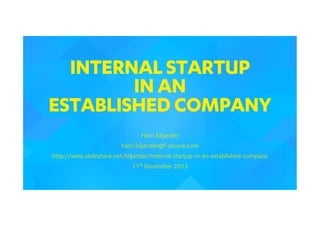Internal Startup in an Established Company
- 1. INTERNAL STARTUP IN AN ESTABLISHED COMPANY Harri Kiljander harri.kiljander@f-secure.com http://www.slideshare.net/kiljander/internal-startup-in-an-established-company 11th November 2015
- 2. Harri Kiljander Job: Director, Personal Identity Protection, F-Secure Harri is a computer scientist who got into information visualization, computer graphics and animation, and UI design in the last millennium. He spent┬Ā15 years at Nokia doing and leading UX design, including NokiaŌĆÖs Linux-based MeeGo smartphone platform. Since 2010 he has been with F-Secure, ’¼ürst leading UX and brand design, then ramping up new consumer security products. In 2012ŌĆō2013 Harri got a task to ŌĆ£work like a startupŌĆØ to build a team to build Lokki, the private location sharing app for families and other groups. Currently HarriŌĆÖs team is building F-Secure KEY, the secure and elegant password management app. Harri is a design advisor┬Āto the B2B2C startup Morelex and an advisor to the EuropeanPioneers startup incubator in Berlin, he holds a PhD in Interactive Digital Media and a number of HCI patents. He is a product designer who wants to bridge design, technology and marketing to create worldŌĆÖs best products. | harri.kiljander@f-secure.com
- 3. INTERNALSTARTUPINAN ESTABLISHEDCOMPANY 1.ŌĆ» Building the internal startup capability and competences; case F-Secure LOKKI 2.ŌĆ» Second generation of F-Secure internal startups, case KEY and Freedome 3.ŌĆ» 10 rules for internal startup founders, investors, advisors, teams, and stakeholders DonŌĆÖt forget to b r e a k t h e r u l e s as appropriate
- 6. LOKKIORIGINS People protection Concept ŌĆ£RingoŌĆØ November2012
- 12. 1. Independent project with maximum control over people+budget+process (laws and company values permitting)
- 13. 2. Clear top-level target setting and top-level sponsor
- 14. 3. Aligned targets with in-house stakeholder teams
- 15. 4. Clear focus, no other obligations for team and team leader
- 16. 5. Somewhat unrealistic schedules & targets balanced with full authority
- 17. 6. Physical co-location of the x-disciplinary team, led by product person
- 18. 7. Team must take product/prototype to the market
- 19. 8. Minimum Viable Product. Build-Measure-Learn. KISS. No dogmas!
- 21. 9. Accept/expect/ appreciate some people getting upset of broken rules
- 22. 10. Continuous improvement and lessons learned
- 24. THE RULES OF SUCCESSFUL F-SKUNK WORKS PROJECTS 1.ŌĆ» Independent project with maximum control over people+budget+process (laws and company values permitting) 2.ŌĆ» Clear top-level target setting and top-level sponsor 3.ŌĆ» Aligned targets with in-house stakeholder teams 4.ŌĆ» Clear focus, no other obligations for teams and team leader 5.ŌĆ» Somewhat unrealistic schedules & targets balanced with full authority 6.ŌĆ» Physical co-location of the x-disciplinary team, led by product person 7.ŌĆ» Team must take product/prototype to the market 8.ŌĆ» Minimum Viable Product. Build-Measure-Learn. KISS. No dogmas! 9.ŌĆ» Accept/expect/appreciate some people getting upset of broken rules 10.ŌĆ» Continuous improvement and lessons learned Adapted from Lockheed MartinŌĆÖs 143 day P-80 jet ’¼üghter prototype project in ŌĆÖ43
- 27. THANK YOU! Time for questions, discussion, debate, feedback, learning! harri.kiljander@f-secure.com http://www.slideshare.net/kiljander/internal-startup-in-an-established-company




























